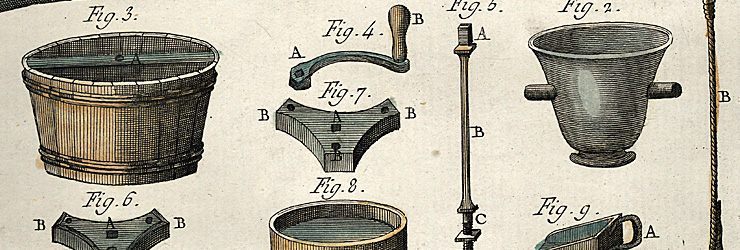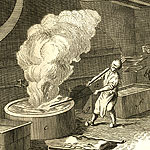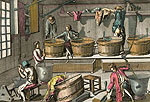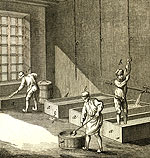
Job and techniques
In Florence dyers originated from the small middle class and were often artisans that learned the art in the family firm and managed their own laboratory with the help of workers, “ciompi” and boys that had only labour functions.

Despite the difficulties in affirming their own political autonomy, they occupied in the Florentine society a position of a certain relief.
Dyers category was divided in three groups, those of the Major Art, perhaps the best organized, that dyed fabrics in various colours, those of the Decorative Arts, specialized in dyes of red colour using the “madder”, vegetable substance from whose roots were extracted the active principle, and finally those of the Art of the Woad, other vegetable used for getting a vast range of blues.
The dyer laboratory had to be necessarily spacious to contain tanks, basins, tubs of various greatness, tubs to stir, boiler and clothes drier, and had to be well aired to be able to expel the smokes and the toxic exhalations that developed during the workmanships.
Water was an element of first necessity, it owed to be abundant, clean and not too much rich of salts. Not by chance the Major Art was situated in the present Corso dei Tintori, parallel to the Lungarno alle Grazie, it exploited Arno waters where then the residues of the workmanships and the dye tanks were poured again with a complicated system of small drains.

Dyes could be of various nature. Some vegetable substances in hot water assured the colour fixing to the fibres without any other treatment as the walnut hull or the bark of some trees. Other substances as the indigo, the saffron and the orchil, required instead a treatment with vinegar or urine that had the power to separate the colouring part and to stare it to the fibres. Other vegetable substances were finally employed such as woad and madder. To assure the duration and the brightness of colours they needed the use of dye fastenings; among these the barks of some trees rich in tannin, some mixtures of ashes and discard products of wine fermentation. But, the alum was the favourite mordant because of its power of assuring the maximum brightness to the fibres, and it was very used from when rich layers were discovered in Tuscany and in Lazio.










